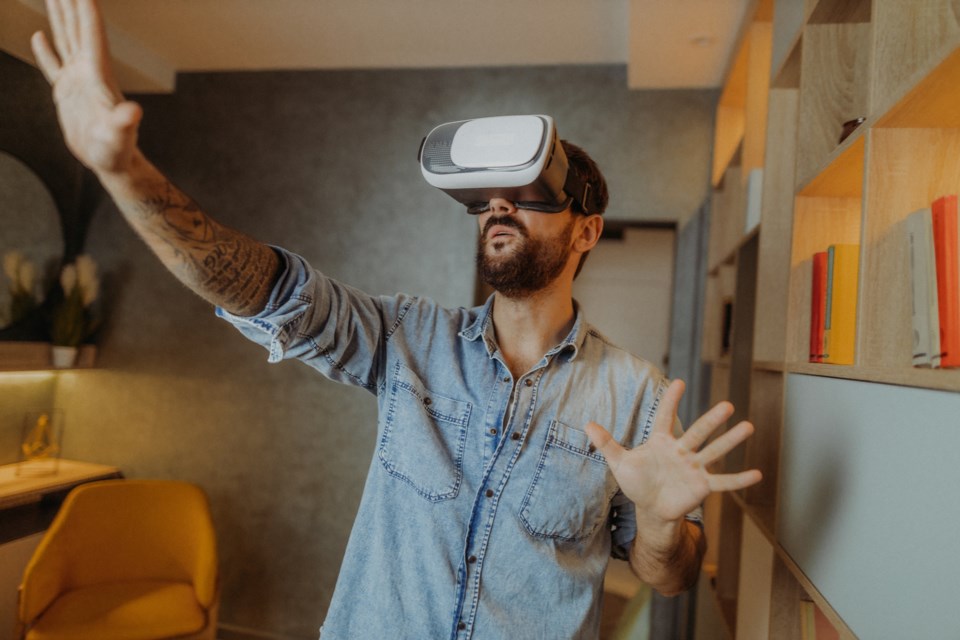Here in Whistler, you wouldn’t think twice about someone walking around in public with ski goggles on their face. You might wonder why the goggles weren’t resting on their head, but they wouldn’t be categorically out of place.
If said person was waving their arms in front of their face, poking and prodding the air, you might give them a funny look—but then, recreational psychedelics are not uncommon in Whistler, either, so you might shrug off the waving arms, too.
But, whether you’re at a ski resort or not, you can expect to start seeing ski goggles and waving arms in public a lot more moving forward.
That’s because on Friday, Feb. 2, Apple officially released its Apple Vision Pro headset—a high-tech set of ski goggles enabling augmented reality and what Apple is calling “spatial computing.”
Videos are already making the rounds of dorky-looking goofs wearing the tech in public, poking at the empty space in front of them and appearing in a reality all their own—because they kinda are.
The headsets start at US$3,499, so, like many Apple products, they will begin life as a status symbol for the wealthy. But virtual and augmented reality tech is far from a fad—even if adoption rates aren’t shooting through the stratosphere (yet).
According to statista.com, about 98 million people will use VR tech this year—a little over one per cent of the global population—while 23 million will dabble with more advanced AR technology, like the Apple Vision Pro.
By 2027, statista estimates more than 100 million people will be using VR and AR tech; an impressive number, but still a far cry from the billions of people who use a smartphone every day.
The VR and AR market is expected to generate about US$38.6 billion in revenue in 2024, and statista estimates the market will grow at an annual rate of about 10 per cent for the next five years.
It’s OK to be skeptical, especially at this early stage when the tech is still developing. But as a recent adopter of a high-end VR headset myself, I suspect those numbers may be conservative in the long-run—because VR has the potential to change everything.
What do you get for looking like a rejected extra from Ready Player One?
To this point, much of the appeal has centred around entertainment—playing video games in virtual reality worlds, or joining chat rooms or poker games with other online avatars in a digital world adjacent our own.
But after spending some time with the tech, you start to appreciate some of the practical possibilities.
The Apple Vision Pro alone has the potential to revolutionize workflows, even if the tech still needs time to develop.
Take the work-from-home debate sparked by the COVID-19 pandemic, which forced companies the world over to re-examine the need for physical office spaces.
Tools like Zoom and Slack helped us connect with our colleagues from home—VR will bring the office itself to our homes.
Soon, all you’ll have to do is strap on your headset, and watch the digital office materialize around you for your morning meeting.
What about on the mountain? The Vision Pro isn’t a suitable substitute for actual ski goggles (yet), but with a little imagination, you can see the potential: a heads-up display showing things like heart-rate, lift-line status, and ops updates, perhaps? Terrain mapping and risk identification? You could even gamify it, adding virtual racing gates, time trials from other skiers, and leaderboards.
The possibilities are endless, here: health-care workers could use spatial computing to check vital signs and patient info; search-and-rescue could use it to keep track of and communicate with each other during risky rescues, or even pick out hard-to-locate subjects; gyms could incorporate it into immersive workouts in wild locales.
But we’re getting ahead of ourselves, of course.
The Harvard Business Review is less optimistic about the transformative power of the Vision Pro—at least for now.
“VR meetings with avatars in pretty rooms do not provide information that is obviously more useful to those in the meetings that might arise from a Zoom call. AR glasses that provide text notifications as you walk around are increasing your cognitive load rather than decreasing it,” wrote economist Joshua Gans, in the Review.
“Our framework suggests that the best use cases will be in contexts where it is normally expensive or dangerous to get information, highlighting the value of VR, or where the environment is so complex that the value of digital overlays to clarify it via AR is high—or both. Think applications like prototyping the design of a new aircraft or building, or assisting in remote medical procedures.”
But that is the tech as it exists now. As Gans points out, Apple’s innovations have a track record of evolving from how they were originally perceived.
“The iPod was a digital walkman. The iPhone was a connected iPod. The iPad was a bigger iPhone. The Apple Watch was a better smartwatch. And the Vision Pro is an unconstrained 3D screen,” he wrote.
“In the previous cases, the device is outgrown and becomes more than that initial use by enabling developer innovation. The Vision Pro is a welcome new experiment along a well-trodden path in computing.”
This isn’t some far-flung future we’re talking about here—the technology exists now, and while it’s still too pricy to truly crack the mainstream, that is changing fast, and options like the Meta Quest (now in three models) are not out of reach for most consumers.
The future—wonderfully weird and wildly exciting—is here.
You just have to be fine with looking like a dork to get full access.




